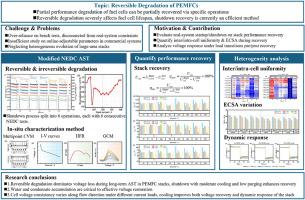Impact of shutdown operations on the recovery of reversible degradation in proton exchange membrane fuel cells
IF 17
1区 工程技术
Q1 ENERGY & FUELS
引用次数: 0
Abstract
In proton exchange membrane fuel cells, partial performance loss accumulated during long-term operation can be recovered through optimized operation or shutdown, a process known as reversible degradation. However, most existing studies focus on small-scale single cells and laboratory-scale test conditions, without adequately considering the constraints inherent to practical system-level operation. Therefore, investigating the influence of practically adjustable shutdown parameters on recovery effectiveness is crucial. Moreover, large-scale stacks exhibit spatial heterogeneity in degradation and recovery, both across cell positions and within individual cells. This heterogeneity plays a key role in identifying reversible degradation and formulating recovery strategies. In this study, accelerated stress tests were conducted on a full-size short stack under New European Driving Cycle conditions. Experimental variables included shutdown temperature, operating temperature, and purging methods, to evaluate their effects on recovery. Changes in stack consistency and electrochemically active surface area before and after recovery were analyzed. Results indicate that moderate retention of condensed water promotes ionomer rehydration and performance recovery, while uneven water distribution leads to spatial differences in recovery. Inter-cell and in-plane inconsistencies increase with current density, with voltage deviations exceeding 40 mV between cells and 20 mV within cells at 594 A. The outlet region exhibited weaker recovery consistency and greater sensitivity to load fluctuations, with response amplification reaching approximately 300 %. Cooling measures during recovery improved both steady-state performance and dynamic response. This work provides important insights into the optimization of shutdown parameters and spatial performance variation in large PEMFC stacks, supporting the development of improved operational strategies to enhance durability and efficiency in practical applications.

关闭操作对质子交换膜燃料电池可逆降解恢复的影响
在质子交换膜燃料电池中,在长期运行中积累的部分性能损失可以通过优化运行或关闭来恢复,这一过程被称为可逆降解。然而,大多数现有的研究都集中在小规模的单细胞和实验室规模的测试条件上,没有充分考虑实际系统级操作固有的约束。因此,研究实际可调的关井参数对采收率的影响至关重要。此外,无论是跨细胞位置还是单个细胞内,大规模堆栈在退化和恢复方面都表现出空间异质性。这种异质性在识别可逆性降解和制定恢复策略方面起着关键作用。在本研究中,在新欧洲驾驶循环条件下对全尺寸短堆进行了加速压力测试。实验变量包括停机温度、操作温度和净化方法,以评估其对回收率的影响。分析了采油前后储层稠度和电化学活性表面积的变化。结果表明,适度的冷凝水保留促进了离聚体的再水化和性能恢复,而水分分布不均匀导致了恢复的空间差异。电池间和面内不一致性随着电流密度的增加而增加,594 A时电池间电压偏差超过40 mV,电池内电压偏差超过20 mV。出口区域的恢复一致性较弱,对负荷波动的敏感性较大,响应放大约为300%。恢复过程中的冷却措施提高了稳态性能和动态响应。这项工作为优化大型PEMFC堆的关断参数和空间性能变化提供了重要见解,支持开发改进的操作策略,以提高实际应用中的耐久性和效率。
本文章由计算机程序翻译,如有差异,请以英文原文为准。
求助全文
约1分钟内获得全文
求助全文
来源期刊

Etransportation
Engineering-Automotive Engineering
CiteScore
19.80
自引率
12.60%
发文量
57
审稿时长
39 days
期刊介绍:
eTransportation is a scholarly journal that aims to advance knowledge in the field of electric transportation. It focuses on all modes of transportation that utilize electricity as their primary source of energy, including electric vehicles, trains, ships, and aircraft. The journal covers all stages of research, development, and testing of new technologies, systems, and devices related to electrical transportation.
The journal welcomes the use of simulation and analysis tools at the system, transport, or device level. Its primary emphasis is on the study of the electrical and electronic aspects of transportation systems. However, it also considers research on mechanical parts or subsystems of vehicles if there is a clear interaction with electrical or electronic equipment.
Please note that this journal excludes other aspects such as sociological, political, regulatory, or environmental factors from its scope.
 求助内容:
求助内容: 应助结果提醒方式:
应助结果提醒方式:


